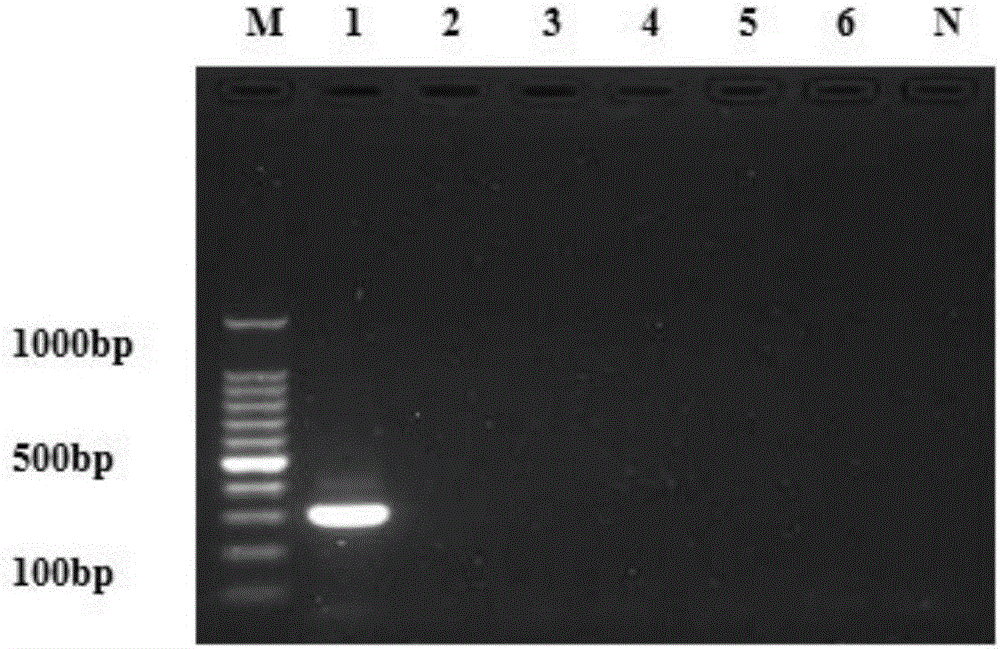Primer pair for identifying chicken parvovirus and application thereof
A technology for chicken parvovirus and primer pair, which is applied to the primer pair for identifying chicken parvovirus and its application field, can solve the problems of time-consuming and labor-intensive sensitivity and low level, and achieve the effects of high practical value, pollution reduction and cost saving.
- Summary
- Abstract
- Description
- Claims
- Application Information
AI Technical Summary
Problems solved by technology
Method used
Image
Examples
Embodiment 1
[0055] Embodiment 1, primer design
[0056] A large number of sequence analyzes and comparisons were carried out to obtain several primers for identifying chicken parvovirus. Preliminary experiments were carried out on each primer to compare performances such as sensitivity and specificity, and finally a pair of primers for identifying chicken parvovirus was obtained.
[0057] The specific primer pair used to identify chicken parvovirus consists of the following two primers (5'→3'):
[0058] ChPV-F (SEQ ID NO: 1 of the Sequence Listing): GTAAATTCTGTGCCGATTGTG;
[0059] ChPV-R (SEQ ID NO: 2 of the Sequence Listing): GAAGTCTGGCTCGTCTGGTAA.
Embodiment 2
[0060] Embodiment 2, optimization of two-temperature formula PCR reaction conditions
[0061] 1. Extract the genomic DNA of chicken parvovirus.
[0062] 2. Take the genomic DNA obtained in step 1 as a template, and use the primer pair prepared in Example 1 to perform two-temperature PCR.
[0063] Two-temperature PCR reaction system (25.0 μL): 2×PCR Mix 12.5 μL, template 1 μL (3.86 ng), ChPV-F and ChPV-R 1 μL each, and finally use ddH 2 O to make up to 25.0 μL. In the two-temperature PCR reaction system, the concentrations of ChPV-F and ChPV-R were both 10 pmol / μL.
[0064] The reaction program of two-temperature PCR: pre-denaturation at 95°C for 3 minutes; denaturation at 94°C for 15 seconds, annealing for 30 seconds, a total of 30 cycles, and extension at 72°C for 10 minutes.
[0065] Set the annealing temperature as follows:
[0066] Annealing temperature I: 51.0°C;
[0067] Annealing temperature II: 51.9°C;
[0068] Annealing temperature III: 53.5°C;
[0069] Anneali...
Embodiment 3
[0078] Embodiment 3, specificity
[0079] 1. Extract the genomic DNA of the sample to be tested. The samples to be tested are: chicken parvovirus (ChPV), Marek virus (MDV), and infectious laryngotracheitis virus (ILTV).
[0080] 2. Extract the total RNA of the sample to be tested and reverse transcribe it into cDNA. The samples to be tested are: Newcastle Disease Virus (NDV), H9 Subtype Avian Influenza Virus (AIV H9), and Infectious Bronchitis Virus (IBV).
[0081] 3. Using the genomic DNA samples obtained in step 1 and the cDNA samples obtained in step 2 as templates, two-temperature PCR was performed using the primer combination prepared in Example 1.
[0082] Two-temperature PCR reaction system (25.0 μL): 2×PCRMix 12.5 μL, template 1 μL (3.86 ng), ChPV-F and ChPV-R 1 μL each, and finally use ddH 2 O to make up to 25.0 μL. In the two-temperature PCR reaction system, the concentrations of ChPV-F and ChPV-R were both 10 pmol / μL. Set up a negative control using an equal vo...
PUM
 Login to View More
Login to View More Abstract
Description
Claims
Application Information
 Login to View More
Login to View More - R&D Engineer
- R&D Manager
- IP Professional
- Industry Leading Data Capabilities
- Powerful AI technology
- Patent DNA Extraction
Browse by: Latest US Patents, China's latest patents, Technical Efficacy Thesaurus, Application Domain, Technology Topic, Popular Technical Reports.
© 2024 PatSnap. All rights reserved.Legal|Privacy policy|Modern Slavery Act Transparency Statement|Sitemap|About US| Contact US: help@patsnap.com










